With a tapestry as vibrant and complex as its diverse cultural fabric, the Democratic Republic of the Congo (DR Congo) stands as a testament to the richness of linguistic diversity. Within its borders thrives a symphony of voices, each representing the echoes of its people’s heritage and history. The languages spoken in DR Congo reveal a nation characterized by profound multilingualism, with approximately 215 recorded living languages according to Ethnologue. The legacy of its Belgian rule is still perceptible in the prominence of French, which remains the official language of DR Congo, serving as a keystone in government, education, and international relations. Alongside, four Bantu languages – Kikongo, Lingala, Swahili, and Tshiluba – are elevated to national status, enabling communication in a country rich in ethnic and linguistic variety.
Such linguistic wealth embodies the essence of a society where communication flows through a multitude of channels, ensuring inclusivity and mutual understanding among its citizens. This multi-lingual dynamic sets the stage for a shared cultural experience, fostering unity within a milieu of languages. Below the weave of its colonial past, the DR Congo’s indigenous tongues continue to resonate, adding depth to this multilingual mosaic.
Key Takeaways
- DR Congo is home to a staggering number of languages, making it a hub of linguistic diversity.
- French serves as the official language, a remnant of its colonial history and a bridge for cross-cultural communication.
- The four national languages, Kikongo, Lingala, Swahili, and Tshiluba, play a crucial role in maintaining the country’s cultural and ethnic diversity.
- Multilingualism in DR Congo aids in uniting its vast population, comprising various ethnic groups and communities.
- Official languages in DR Congo function at multiple levels, from governmental administration to everyday communication among citizens.
- Understanding the scope and function of languages in DR Congo can offer insights into the nation’s identity and social fabric.
The Lingua Franca of DR Congo: A Multilingual Nation
The Democratic Republic of the Congo, a kaleidoscope of cultures and ethnicities, is a beacon of language diversity. It stands proudly as a multilingual hub, where the convergence of numerous languages paints a vivid picture of its colonial and ethnic tapestry. At the forefront of this linguistic melody are French, Lingala, Swahili, and several indigenous dialects, woven intricately into the daily life and identity of the Congolese people.
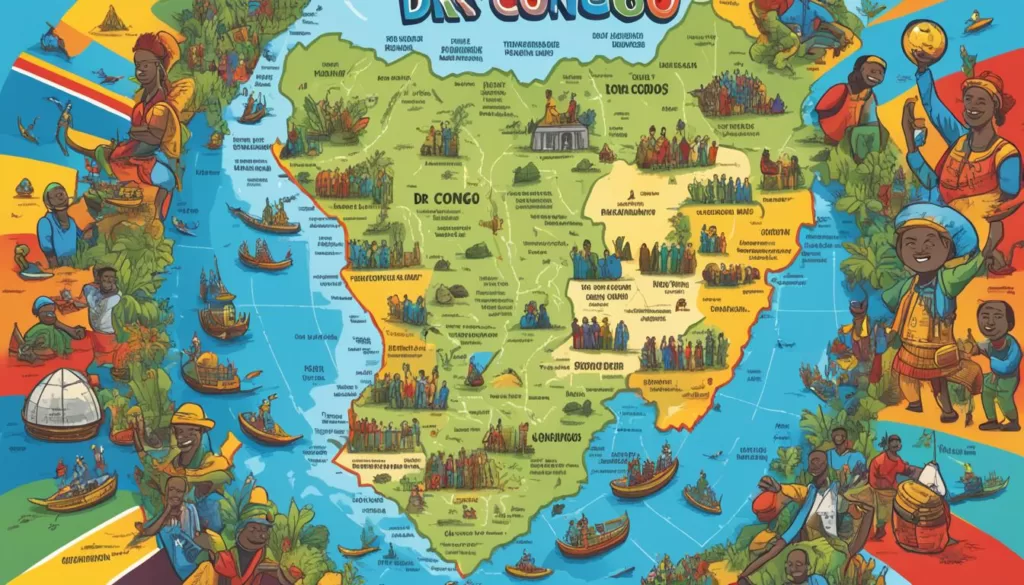
Within the bustling streets of Kinshasa and beyond, French echoes as the voice of government, trade, and education, reaching at least 74% of the Congolese populace who communicate in this lingua franca. As a vestige of the colonial era and a neutral medium amongst numerous ethnic groups, French’s preeminence in the DR Congo has been sustained and nurtured over decades.
Yet, the melody of Congolese communication would be incomplete without the resounding rhythms of Lingala. Historically channeled through the upper reaches of the Congo River and propagated by missionaries, Lingala has been championed as the lingua franca of the army and holds significant sway in urban centers and music, signifying its potent socio-cultural influence.
| Language | Role in DRC | Percentage of Speakers |
|---|---|---|
| French | Official language used in government, international relations, and as a lingua franca | 74% |
| Lingala | Lingua franca in the army, popular in urban areas and music industry | Second-most spoken language |
| Swahili | Widely used in the eastern regions, serves as a bridge language in trade and communication | Widespread in relevant regions |
The language landscape is further enriched by the widespread usage of Swahili, especially in the east, acting not only as a thread in the national fabric but also as a connective language to neighboring regions in the continent. Its versatility and broad reach render it indispensable for cross-border commerce and cultural exchange.
In essence, the language diversity in the DR Congo reflects its historic roots and stands as a symbol of unity in an ethnically diverse nation. It is a testament to the adaptability and resilience of its people, who have woven foreign and native tongues into a rich linguistic quilt that blankets their harmonious coexistence.
Languages Spoken DR Congo: Unveiling Linguistic Diversity
The Democratic Republic of the Congo (DR Congo) is a rich tableau of linguistic variety, with a repertoire of indigenous languages that span over two hundred tongues, each whispering the story of the nation’s diverse ethnolinguistic heritage. This profusion of indigenous languages DR Congo creates a complex, yet coherent linguistic puzzle where every piece is vital to the cultural integrity of the nation.
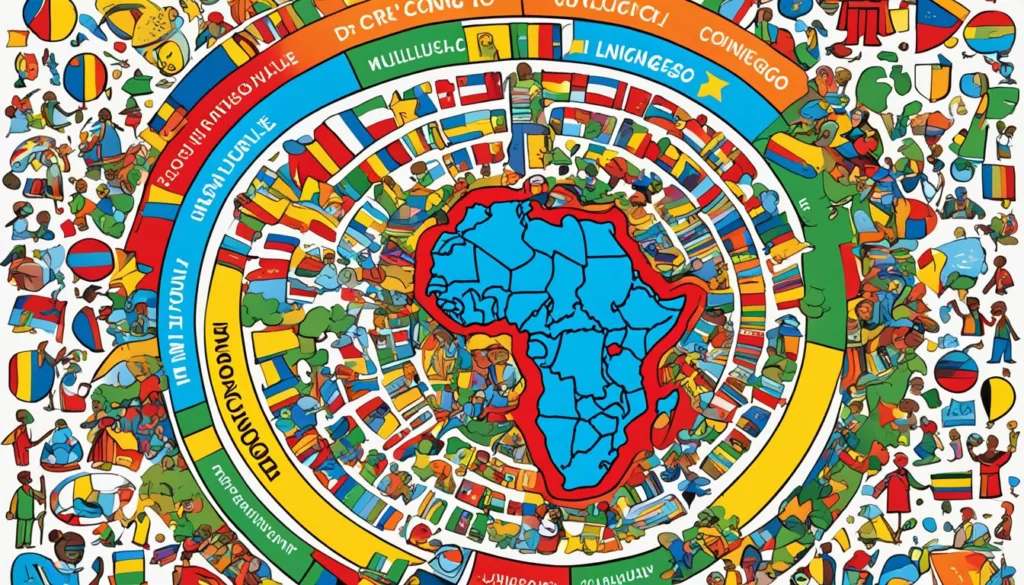
This linguistic diversity serves as an anchor for personal and collective identities. Among the myriad of languages, four have been elevated to a special status of national recognition. Kikongo and Tshiluba are particularly notable, woven into the very fabric of the DR Congo’s national and regional identity.
Kikongo, with its variations, captures the spirit of the Bakongo people, resonating in the west and southwest provinces. Meanwhile, Tshiluba emerges as the linguistic heart for the Luba people in the central part of the nation. Both languages, in their essential roles, function as conduits for administrative, educational, and social interactions within their respective communities.
- Kikongo: A Language Interwoven with History
- Tshiluba: Reflecting the Essence of Central DR Congo
- Endangered Tongues: The Precious Atoll of Lesser-Known Languages
- Language Policies: Challenges and Triumphs in Preservation and Promotion
Here is a snapshot of how these national languages DR Congo contribute to the complex linguistic narrative of the nation:
| Language | Region Predominance | Functional Roles |
|---|---|---|
| Kikongo (Kituba) | West and Southwest | Primary language for local governance and day-to-day communication. |
| Tshiluba | Central DR Congo | Used for regional administration, education, and indigenous cultural expression. |
Through the timeless echoes of Kikongo, from the soul-stirring syllables of Tshiluba, to the lesser-spoken but equally significant dialects that thrive in the myriad communities of the DR Congo, there is a unanimous affirmation of diversity. This is not mere multilingualism; it is a celebration of linguistic vitality that forms an inextricable link to identity, community belonging, and cultural continuity.
Amidst this polychromatic ensemble of dialects and accents lies a reminder that the true essence of the Democratic Republic of the Congo is voiced not through one, but many tongues, articulating a shared history and a collective vision for the future.
French: The Official Language of DR Congo
Amidst the symphony of languages that define the DR Congo, French resonates as the official language, an enduring testament to the country’s colonial legacy. Having originated from the Belgian colonial rule, French has transcended its history to become a unifying force within the nation’s multiplex of ethnic diversities. The implementation of French, which dates back to the colonial era, solidified its role as the chief medium for administration, education, and global diplomacy, a mantle it continues to hold in post-independence DR Congo.
Even today, the echoes of French pervade the Congolese capital, Kinshasa, reinforcing its stance as an essential tool for fostering communication and cultural unity in a society with over 200 indigenous languages. With the largest population of French speakers globally, DR Congo not only cherishes the linguistic ties with its Francophone counterparts but also embraces the threads of French influence that are woven through the tapestry of Congolese culture.
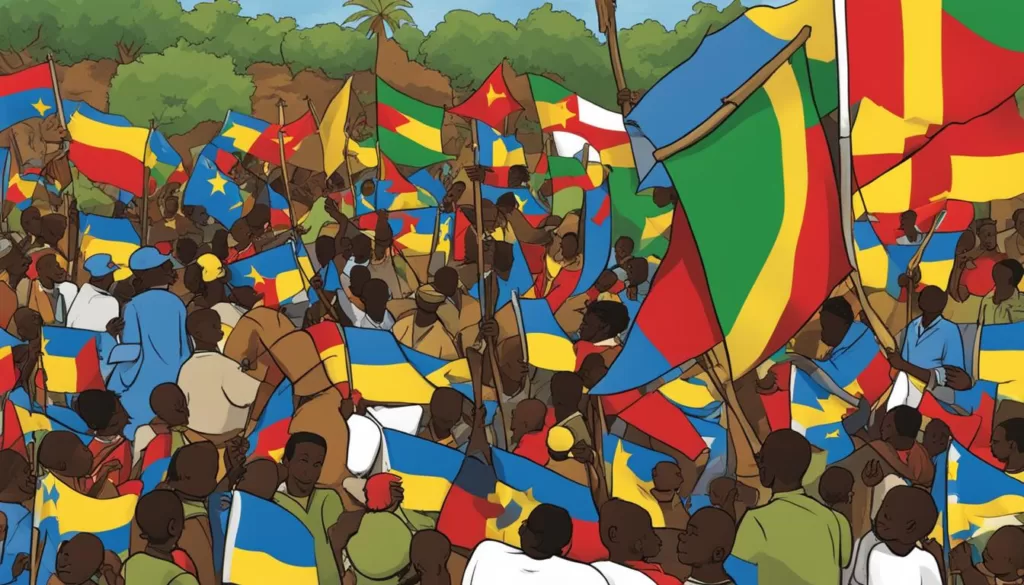
Colonial Legacy and Modern Usage
The imprint of Belgium’s dominion is indelible in the widespread use of French as the lingua franca in DR Congo. This colonial footprint has molded French into a bridge across the ethnic mosaic of the country, providing a neutral linguistic platform for discourse and governance. It safeguards the integrity of communication in a landscape peppered with a rich diversity of mother tongues, easing the path to administer and educate across varying dialects and languages.
French as a Language of Instruction and Business
With deep roots entrenched within the Congolese educational infrastructure, French stands as the primary language of instruction from primary schools to higher educational institutions. This central role of French extends to the world of commerce where it functions as the key business language, forging economic interactions both domestically and internationally. Proficiency in French is highly prized, offering Congolese citizens a competitive edge in the job market and widening their horizon for professional opportunities.
French Influence on Congolese Culture and Society
Far surpassing the formal domains of governance and learning, the essence of French blends seamlessly with the fabric of Congolese society. The language serves as a conduit of cultural expression, evident in various forms of art, literature, and societal norms. Adapting to the local environment, a distinct variant of French has emerged, tailored to the rhythms of the Congolese speech patterns and cultural context—fostering a unique dialectic blend of African and European linguistic elements. The conversation between French and the diverse ethnic languages of DR Congo continues, strengthening the ties that bind the Congolese people with a shared cultural identity.
Through its intertwined relationship with the people, French in DR Congo emulates more than just a colonial relic. It is an active participant in the symphony of linguistic diversity that characterizes the heart of the Congolese nation, harmonizing historical influences with contemporary needs and aspirations.
National Languages of DR Congo: Beyond the Official Tongue
Delving into the heart of the Democratic Republic of the Congo’s (DR Congo’s) cultural heritage requires an appreciation for its national languages. Being a country with a linguistic tapestry as rich and diverse as its landscapes, DR Congo recognizes four national languages beyond French: Kikongo ya leta, Lingala, Kituba, and Swahili. These languages serve as vital communicative tools, bridging and bonding diverse communities across the nation.
The evolution of these languages from their historical roots to their contemporary status as vehicles of native identity and administration is fascinating. Kikongo ya leta, a variant of the Kikongo language, has transformed into Kituba, a creole that is extensively used in government and everyday conversation, especially in the provinces of Bas-Congo, Kwango, and Kwilu. Its role as an administrative language reflects its practicality and accessibility among the Congolese population.
Lingala’s history is rooted in its military usage but has since become ubiquitous in media and music, permeating daily life and culture in urban hubs and along the Congo River. The language’s adaptability has secured its place as both a symbol of cool modernity and a resilient echo of traditional forms of oral storytelling.
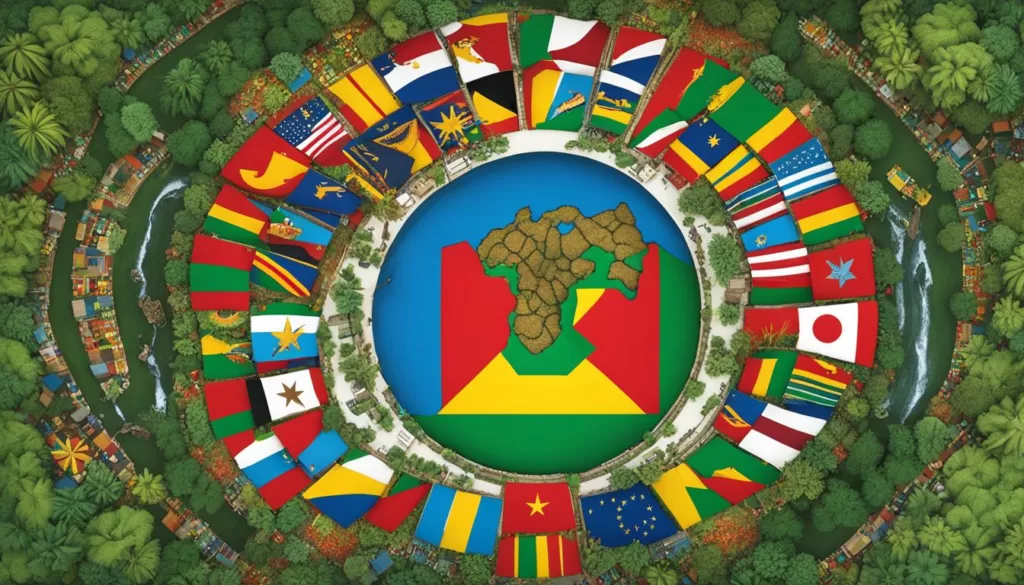
The linguistic reach of Swahili extends well beyond the DR Congo, dominating conversations in the trade and intercultural dialogue of East and Central Africa. Its influence is profoundly felt within the communities along the eastern borders, woven into the very fibers of business and social alliances.
Here, we encapsulate the core statistics reflective of the indispensable role these national languages play:
| Language | Regions of Predominance | Role in Congolese Society |
|---|---|---|
| Kituba (Kikongo ya leta) | Bas-Congo, Kwango, Kwilu | Administrative communication and daily vernacular |
| Lingala | Kinshasa, Congo River regions | Military, music industry, urban culture |
| Swahili | Eastern DRC, border regions | Trade, cross-border relations, local governance |
Experiencing the DR Congo through the lens of its national languages DR Congo reveals a panorama of dynamic cultural expressions and identities. Kituba, Lingala, and Swahili exist not merely as tools of communication but as living, breathing embodiments of the Congolese way of life. In national interactions, education, commerce, or informal discourse, these languages stand as pillars supporting the nation’s multilingualism.
The disparate sounds of dialects and accents in a bustling Kinshasa marketplace or the rhythmic greetings along the shores of the Congo signify more than just language—they represent the pulse of a nation. It’s an auditory adventure, where words in Kikongo ya leta or Lingala carry with them narratives of the past, recipes for community, and the keys to tomorrow’s understanding. In such a context, multilingualism in the DR Congo isn’t just a fact of life—it’s a celebration.
Indigenous and Regional Languages: Preserving Local Identity
The rich spectrum of languages spoken within the borders of the Democratic Republic of the Congo (DR Congo) represents much more than mere communication tools; they are the bearers of tradition, identity, and the very soul of numerous ethnic communities. The significance of the Bantu languages such as Lingala, Tshiluba, and Kikongo extends well beyond their use in colloquial exchanges, as they are key to the cultural unity and identity within DR Congo. Amidst the harmonious disarray of dialects, it becomes clear that the preservation of indigenous languages DR Congo is critical to maintaining the cultural richness of this vast nation.
Bantu Languages and Their Significance
The Bantu languages, encompassing Lingala, Tshiluba, and Kikongo among others, are not merely strings of words but embodiments of DR Congo’s profound history and diverse cultural landscapes. Each phrase and each term transmits the wisdom of ancestors and the essence of indigenous lifestyles, which is why language preservation is so crucial in a multilingual country like DR Congo. In a world that is rapidly modernizing, these languages stand as a testament to the nation’s commitment to its roots, offering a sense of belonging and continuity for future generations.
Influence of Indigenous Languages on National Culture
The tapestry of the Democratic Republic of the Congo’s national culture is intricately woven with threads of its indigenous languages. These tongues touch every aspect of daily life, shaping music, fueling the richness of cuisines, and underpinning societal norms. They enable the sharing of folklore, perpetuate traditional knowledge, and celebrate community values, infusing a distinctive character into the collective identity of the Congolese.
Challenges and Efforts in Language Preservation
While the DR Congo’s dedication to multilingualism is evident, its diverse linguistic landscape faces the threat of language loss. The challenge of ensuring that each unique dialect continues to thrive is met with concerted efforts by governmental and cultural bodies. Educational reforms have been instigated to encourage the learning and usage of indigenous languages, while cultural programs aim to celebrate and invigorate this precious heritage. The success of these initiatives will be measured by the ability of the DR Congo to maintain a living dialogue with its rich ancestral legacies.
Amid these efforts, the everyday reality of linguistic interchange in the bustling markets, in the songs of the local minstrels, and in the hushed tales of elders, are dynamic acts of language preservation. Each conversation in Tshiluba, each proverb in Lingala, and each incantation in Kikongo reaffirms the enduring power of language to unite a people and tell the story of their land.
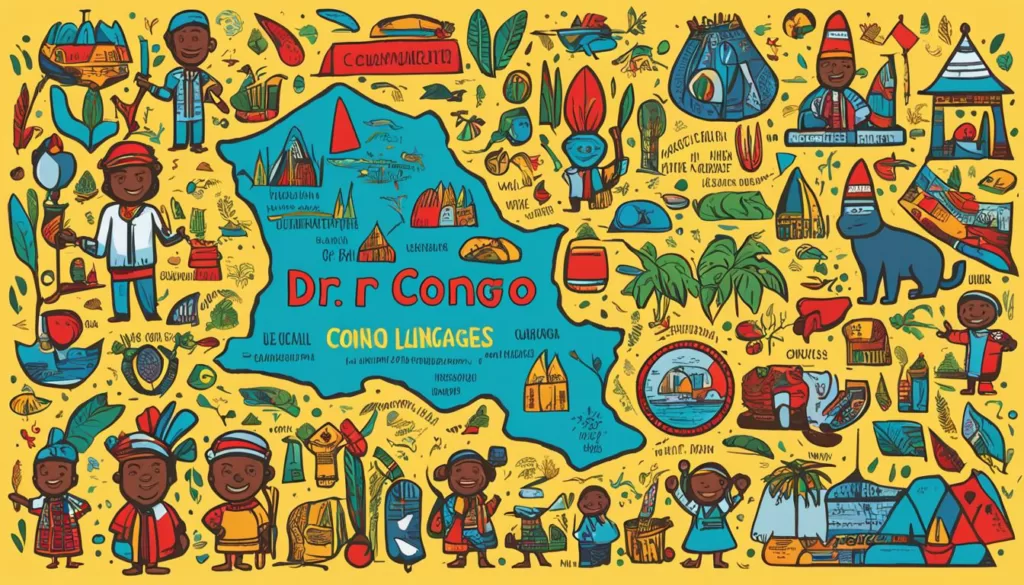
Conclusion
The linguistic tapestry of the Democratic Republic of the Congo (DR Congo) beautifully encapsulates the nation’s complex history and the rich cultural fabric woven by its people. With its multitude of voices and ethnicities, DR Congo is a resounding testament to the power of language diversity. This myriad of languages characterizes the daily existence of the Congolese, allowing communities to maintain their unique identities while contributing to the larger narrative of the nation. It is in the relay of dialects and the exchange of words that cultural unity and social cohesion are solidified, creating a society rich in diversity and steeped in shared heritage.
Moreover, the role of multilingualism in DR Congo transcends cultural preservation; it fosters connectivity and mutual understanding among the varied population segments. Communications that span from the corridors of government, where French dominates, to the colloquial exchanges in Lingala, Kikongo, and Swahili highlight the significance of linguistic plurality. In acknowledging and promoting the languages spoken in DR Congo, the country acknowledges the essential bridges that facilitate unity and progress.
The Importance of Language Diversity in DR Congo
Linguistic plurality is not a mere consequence of geography and history but a potent emblem of the Congolese spirit. Language diversity in DR Congo brings color and dimension to everyday interactions, enshrining traditions and forwarding contemporary expressions of identity. The assortment of languages gives voice to stories, songs, customs, and the undying essence of the Congolese people, nurturing a nation where history is honored, and the future is embraced with a multilingual welcome.
The Role of Multilingualism in Unity and Communication
The harmonious interplay of languages is evident in the ease with which the populace of DR Congo dips into the rich lexicon of their multilingual heritage to communicate, collaborate, and celebrate. In embracing the linguistic assets of its people, DR Congo strengthens the pillars of societal harmony and demonstrates that multilingualism is not simply about coexistence—it is the very heartbeat of unity and cultural synergy. As the globe shrinks and nations intertwine, the DR Congo’s commitment to maintaining the vibrancy of its verbal mosaic is both a nod to the past and a beacon for the future—displaying solidarity and sophistication in its chorus of tongues.
FAQ
What languages are spoken in DR Congo?
DR Congo is a multilingual nation with an estimated 215 living languages. The official language is French, and there are four national languages: Lingala, Swahili, Kikongo, and Tshiluba. These, along with numerous indigenous languages, reflect the country’s vast cultural diversity.
Why is French the official language of DR Congo?
French was established as the official language during the Belgian colonial period and has been maintained post-independence due to its neutrality amongst the various ethnic groups and its widespread use, especially in the capital city of Kinshasa.
What is the lingua franca of DR Congo?
While French is the official language, several languages act as lingua francas within their regions. Lingala is predominant in Kinshasa and the army, Swahili in the East, and Kikongo along the western coast. Across the nation, multiple languages are used to enable communication among different ethnic groups.
Are there any indigenous languages in DR Congo?
Yes, DR Congo has over 200 indigenous languages spoken by various ethnic groups. These native languages play a significant role in expressing local culture, traditions, and community values.
What initiatives are in place for language preservation in DR Congo?
DR Congo is making efforts to preserve its language diversity through educational policies that incorporate indigenous languages into curricula and cultural initiatives that promote the use and documentation of local languages.
How does multilingualism impact unity in DR Congo?
Multilingualism in DR Congo serves as a unifying force, allowing for communication across diverse population segments. Embracing the country’s linguistic plurality fosters national unity and accommodates multiple voices and identities within the society.
How does French influence Congolese culture and society?
French has a significant influence on Congolese culture and society. It is deeply embedded in education, government, and business. Fluency in French also improves job prospects, and the language’s cultural influence is evident in a distinct Congolese French dialect and its role in mediating ethnic diversity.
What role do Bantu languages play in DR Congo?
Bantu languages such as Lingala, Kikongo, Swahili, and Tshiluba are intrinsic to the DR Congo’s linguistic heritage. These languages reflect the diverse ethnicities and are key to daily communication, cultural practices, and preserving historical narratives across various regions.






